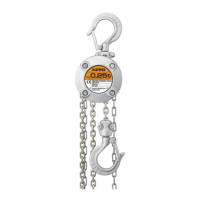21
(Continued on the following page)
Frequent Inspection
Check the Chain Hoist under the installation state or
on the workbench.
Check the following items in addition to the daily inspection items.
Before a frequent inspection, perform the daily inspection.
NOTE
Item Method Discard limit or criteria Action
Basic
function
Suspend a light load and lift/
lower it.
• Lifting operation should make regular click
sounds of the Pawl of the brake unit and
perform smoothly.
• Sounds should be at a constant level or no
irregular clicks should be heard.
• No sounds should be made when lowering.
• It should be free of any heavy pulling force.
• There should be no slip in braking.
Disassemble the Chain
Hoist to verify that
the hoist is properly
assembled and the
components are free of
defects.
Top and
Bottom
Hooks
Visual check • The hook should not be signicantly twisted
or deformed.
• Should be free of any deep notches of aws.
• Should be free of any loosened or omitted
rivets, bolts or nuts.
• Should be free of any foreign matter such as
sputter on the Hook.
Replace the Top Hook
Set or the Bottom Hook
Complete Set.
Measure the dimensions of
each "a", "b" and "c" of the
Top and Bottom Hooks using
calipers.
The nominal values are indicated
below for reference, however, the Hook
dimensions have tolerances to some
extent because it is forged and thermally
treated.
Replace the Top Hook
Set or the Bottom Hook
Complete Set.
Standard Limit
Dimension a
Not to exceed the dimension when
purchased
Dimension b 5% or more wear
Dimension c 5% or more wear
b
c
a
Embossed mark
Compare the deformation and
thickness of the Top and Bottom
Hooks with those of when
purchased to check they are not
beyond the criteria.
Using Hook with dimensions beyond the criterion
may result in injury or damage to property.
Rated
load (t)
Dimension a Dimension b Dimension c
Standard
Standard
Limit
Standard
Limit
0.25 39 11
10.5 12.5 11.9
0.5 45.5 12
11.4 15 14.3

